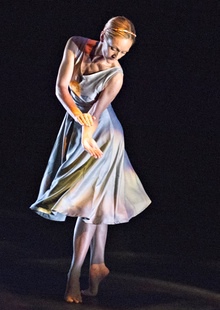Yorke Dance Project review – dance past, present and future

Looking back at 20th-century modernist art, one is struck by the certainty it embodies. The writing of Eliot, the music of Ives and Stravinsky, the sculpture of Moore, the painting of Rothko. Even at its most experimental it has mass and authority; it is never tentative. Modernist choreography shares these attributes. Considering works such as Balanchine’s Apollo or MacMillan’s Song of the Earth from today’s postmodern perspective is like viewing the Pyramids from the desert. They are vast and immutable; you are on shifting, windblown ground.
I had this impression watching Robert Cohan’s Canciones del Alma (Songs of the Soul), created in 1978 and presented by Yorke Dance Project, formed in 2009 by Yolande Yorke-Edgell. Cohan, born in New York in 1925, is one of the giants of modern dance. A leading member of Martha Graham’s company in the postwar years, he was the founding director of the London Contemporary Dance School and of its professional wing, London Contemporary Dance Theatre.
yoland yorke-edgell
Yolande Yorke-Edgell in Canciones Del Alma: ‘radiates outwards even as she draws inwards’. Photograph: Tony Nandi
Canciones del Alma was inspired by the poems of the 15th-century Spanish mystic St John of the Cross, three of which the composer Geoffrey Burgon has arranged for orchestra and countertenor male voice. Performed by Yorke-Edgell, the piece describes the journey of the soul through the noche obscura, the dark night, to final union with the Creator, whom the poet presents in the form of a lover.
But a lover within the self, as Cohan’s choreography makes clear. This is no simple walk into the light. As Yorke-Edgell first resists – body language quivering and fretful, arms pushing fearfully away – and then surrenders herself to ecstasy, you have the sense of an almost sexual capitulation. And, in the angularity and anguish of the physical vocabulary, a real sense of that dark night and the abyss it conceals. This is the mysticism of old Europe, presented not as the high baroque of Bernini’s swooning St Teresa, but with spare, almost austere, gravity. Yorke-Edgell’s self-containment and authority as a performer count for everything here; she radiates outwards even as she draws inwards.
Cohan’s piece is followed by one of Yorke-Edgell’s own. Unfold to Centre is a work for six dancers set to sound compositions by Kazu Matsui and Joseph Hyde, and to a computer-generated light installation by Larry Cuba. The movement is deep and grounded, with broad pliés and lunges, and swooping seagull arms reminiscent of those in Merce Cunningham’s Beach Birds. The dancers’ performances are rewardingly fine, particularly in the central duet for Jonathan Goddard and Laurel Dalley Smith. Rowan Heather is also a notable presence.
No Strings Attached, danced by the same six performers, was created by Charlotte Edmonds in 2013. Edmonds was then 16 and a student at White Lodge (the Royal Ballet junior school), where she had twice won its most prestigious choreography award. A coolly measured piece, set to the first movement of Michael Gordon’s Weather, it matches the music’s capricious swirl with full-body ripples and a low-slung neoclassicism. Gordon’s composition is clearly influenced by Vivaldi, and Edmonds responds with swift, elegant passages danced in canon. As a dance work, No Strings Attached is both accomplished and sophisticated; as the creation of a student it’s astonishing. “I love to dance,” Edmonds tells me afterwards. “But choreography is my passion.”
charlotte edmonds
Choreographer Charlotte Edmonds: ‘assessed out’ of the Royal Ballet’s upper school. Photograph: Yorke Dance Project
So it’s depressing that she has not been permitted to continue her studies at the Royal Ballet upper school, but instead has been – as the school’s grim terminology has it – “assessed out”. Edmonds is stoical but clearly wounded. “They’re fixated on physique,” she tells me, explaining why she didn’t make the cut. Not for the first time, one is left slack-jawed at the establishment’s lack of foresight, and by a selection process that’s as cruel as it is counterproductive. Had Edmonds been a boy, the story might have been different; the Royal has traditionally found room in its ranks for talented male choreographers. But women have seen their paths to the Covent Garden main stage blocked, and no new work by a female choreographer has been seen there since the late 1990s. This is unacceptable in 21st-century Britain, and until the Royal gets its house in order, starting with the school, it will continue to miss out on artists like Charlotte Edmonds.